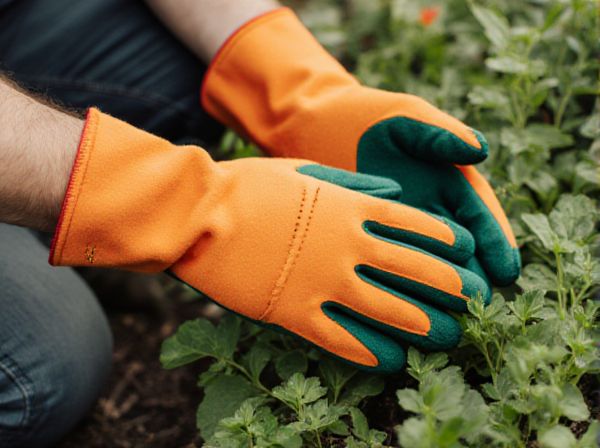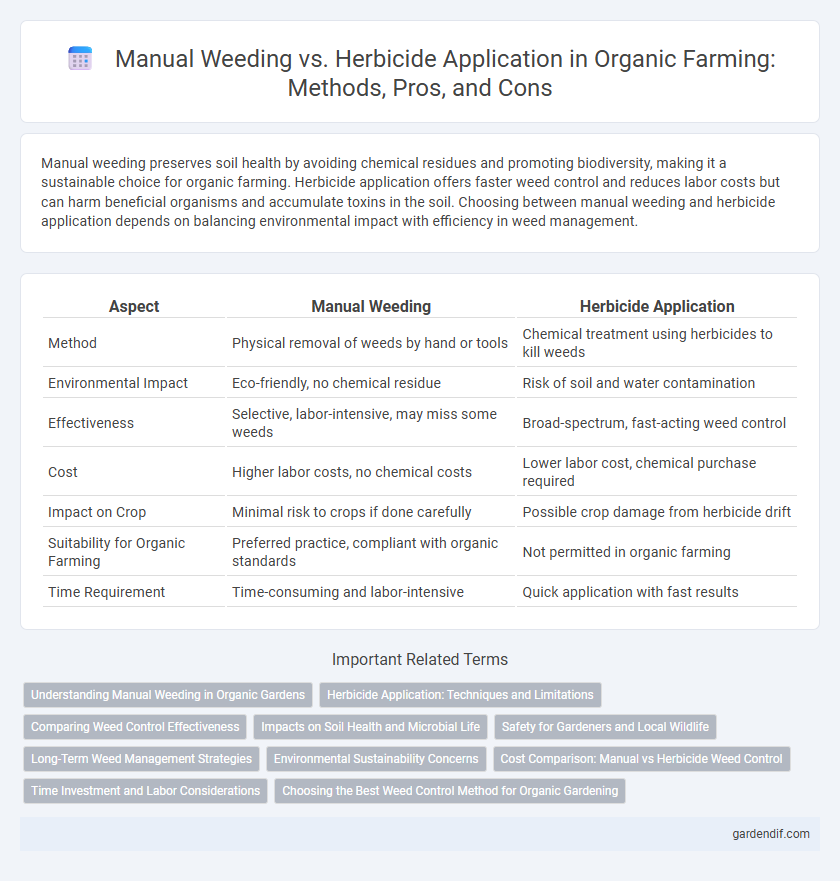
Manual Weeding vs Herbicide Application Illustration
Manual weeding preserves soil health by avoiding chemical residues and promoting biodiversity, making it a sustainable choice for organic farming. Herbicide application offers faster weed control and reduces labor costs but can harm beneficial organisms and accumulate toxins in the soil. Choosing between manual weeding and herbicide application depends on balancing environmental impact with efficiency in weed management.
Table of Comparison
| Aspect | Manual Weeding | Herbicide Application |
|---|---|---|
| Method | Physical removal of weeds by hand or tools | Chemical treatment using herbicides to kill weeds |
| Environmental Impact | Eco-friendly, no chemical residue | Risk of soil and water contamination |
| Effectiveness | Selective, labor-intensive, may miss some weeds | Broad-spectrum, fast-acting weed control |
| Cost | Higher labor costs, no chemical costs | Lower labor cost, chemical purchase required |
| Impact on Crop | Minimal risk to crops if done carefully | Possible crop damage from herbicide drift |
| Suitability for Organic Farming | Preferred practice, compliant with organic standards | Not permitted in organic farming |
| Time Requirement | Time-consuming and labor-intensive | Quick application with fast results |
Understanding Manual Weeding in Organic Gardens
Manual weeding in organic gardens involves physically removing weeds by hand or with tools, preserving soil health and avoiding chemical residues. This method enhances biodiversity by protecting beneficial insects and microorganisms essential for a balanced ecosystem. Regular manual weeding reduces weed competition, promoting stronger growth of organic crops without compromising environmental safety.
Herbicide Application: Techniques and Limitations
Herbicide application in organic farming involves precise techniques such as spot spraying and using biodegradable formulations to minimize environmental impact and preserve soil health. These methods effectively target unwanted weeds while reducing chemical residues, yet limitations include potential harm to non-target plants and the need for careful timing to avoid crop damage. Despite advancements, organic standards often restrict synthetic herbicides, pushing growers to balance efficacy with eco-friendly practices.
Comparing Weed Control Effectiveness
Manual weeding provides precise removal of weeds without chemical residues, ensuring minimal soil disruption but requires significant labor and time. Herbicide application offers rapid and broad-spectrum weed control, effectively managing large infestations but may impact soil health and beneficial organisms. Evaluating weed control effectiveness depends on the specific crop, weed species, environmental conditions, and sustainability goals within an organic farming system.
Impacts on Soil Health and Microbial Life
Manual weeding preserves soil structure and enhances microbial diversity by avoiding chemical disturbances that herbicides cause, which often reduce beneficial microbial populations. Herbicide application can disrupt soil enzymatic activities and nutrient cycling, leading to long-term soil degradation and decreased fertility. Organic farming practices emphasizing manual weeding foster healthier, more resilient soil ecosystems critical for sustainable crop production.
Safety for Gardeners and Local Wildlife
Manual weeding eliminates chemical exposure risks, ensuring safer conditions for gardeners and preserving local wildlife habitats by avoiding toxic herbicide residues. Herbicide application can introduce harmful substances into soil and water, posing threats to pollinators, beneficial insects, and nearby aquatic ecosystems. Prioritizing manual methods supports sustainable gardening practices that protect biodiversity and human health.
Long-Term Weed Management Strategies
Manual weeding enhances soil health by minimizing chemical residues and promoting biodiversity, essential for sustainable organic farming. Herbicide application can offer immediate weed control but risks developing herbicide-resistant weed populations over time. Integrating crop rotation, cover cropping, and manual weeding forms an effective long-term weed management strategy that sustains soil fertility and reduces dependency on chemical inputs.
Environmental Sustainability Concerns
Manual weeding preserves soil biodiversity and prevents chemical runoff, making it a preferable choice for environmentally sustainable farming practices. Herbicide application, while efficient, poses risks of soil contamination and harm to non-target organisms, potentially disrupting local ecosystems. Choosing manual weeding minimizes ecological impact and supports long-term soil health in organic agriculture.
Cost Comparison: Manual vs Herbicide Weed Control
Manual weeding incurs higher labor costs due to intensive human effort required, whereas herbicide application involves lower labor but additional expenses for chemical purchase and equipment. In organic farming, manual weeding aligns with sustainable practices despite being more time-consuming and costly upfront. Herbicide use, while generally more cost-effective, is limited or prohibited in organic systems, influencing overall weed control expenses and crop viability.
Time Investment and Labor Considerations
Manual weeding demands significant time investment and physical labor, often requiring repeated efforts throughout the growing season to control weeds effectively. Herbicide application offers faster treatment over larger areas but entails careful timing and safety precautions to prevent crop damage and environmental harm. Organic farming typically favors manual weeding to maintain soil health and biodiversity, despite its higher labor intensity.
Choosing the Best Weed Control Method for Organic Gardening
Manual weeding in organic gardening ensures precise weed removal without chemical residues, preserving soil health and beneficial microorganisms. Herbicide application, though faster, is typically avoided in organic practices due to synthetic chemical restrictions and potential environmental harm. Selecting the best weed control method depends on garden size, weed infestation level, and commitment to organic standards, with manual weeding favored for sustainability and herbicides reserved for non-organic contexts.
Manual Weeding vs Herbicide Application Infographic

 gardendif.com
gardendif.com